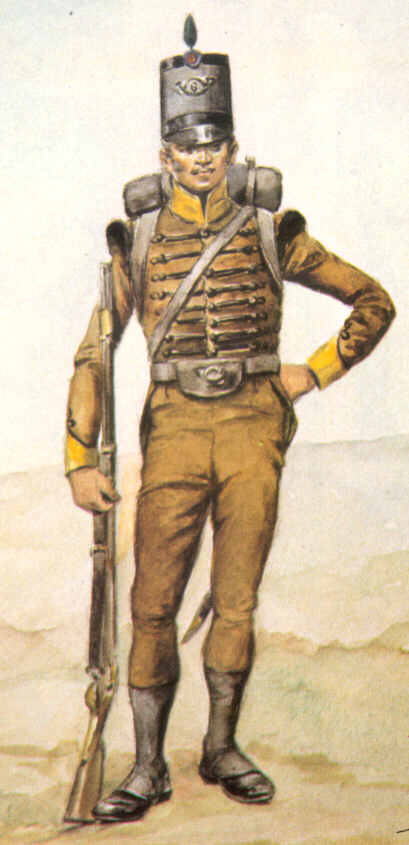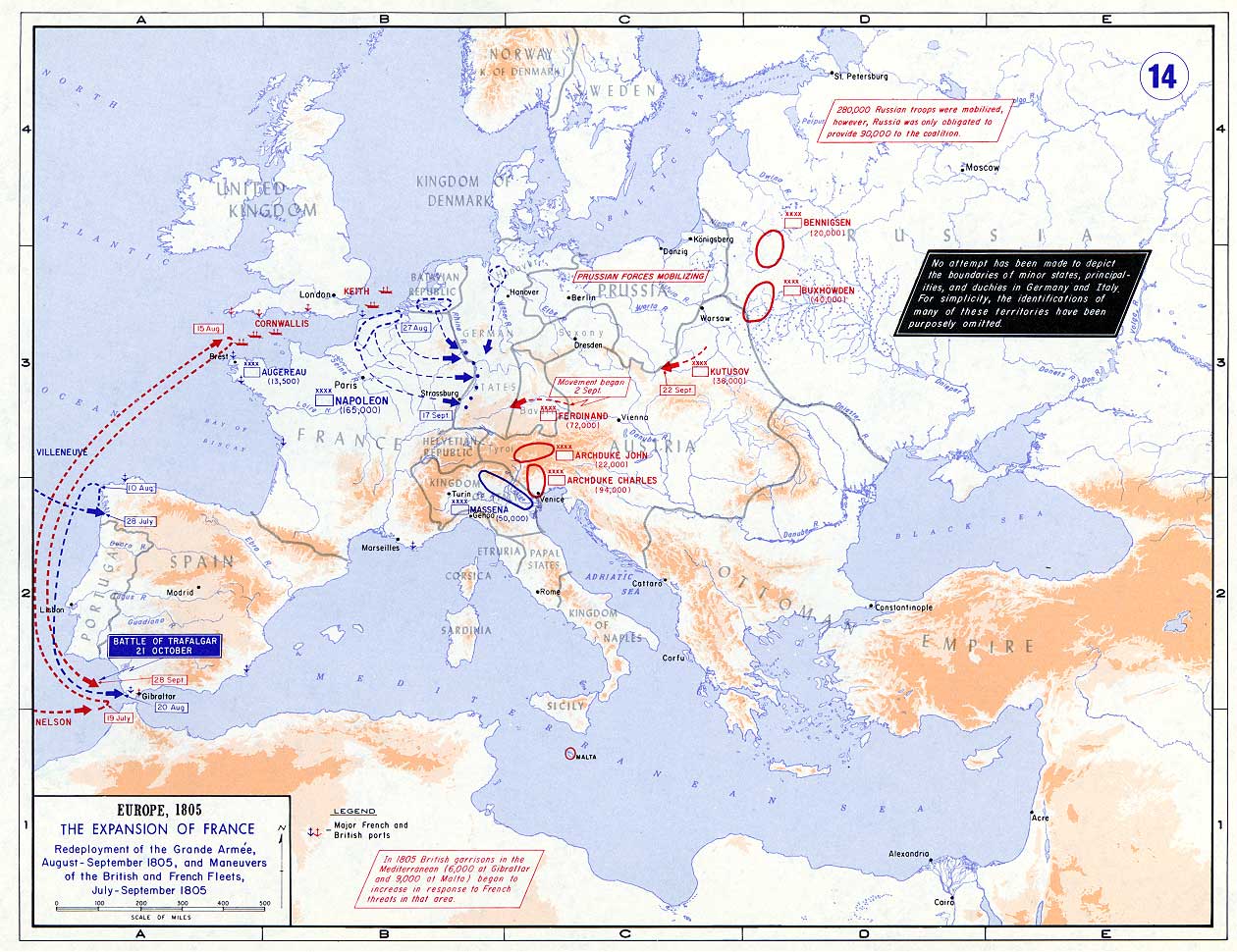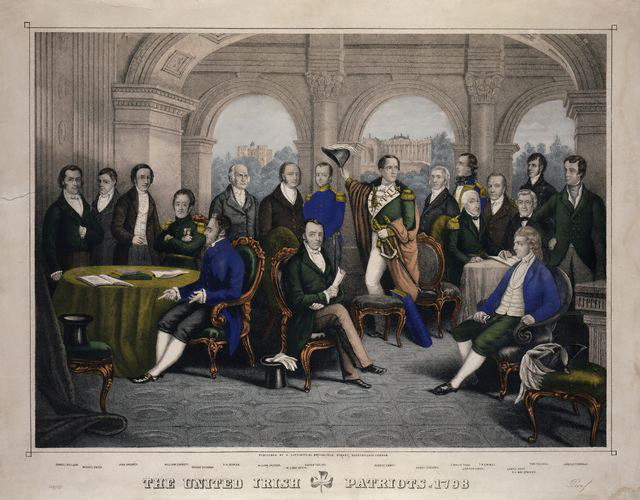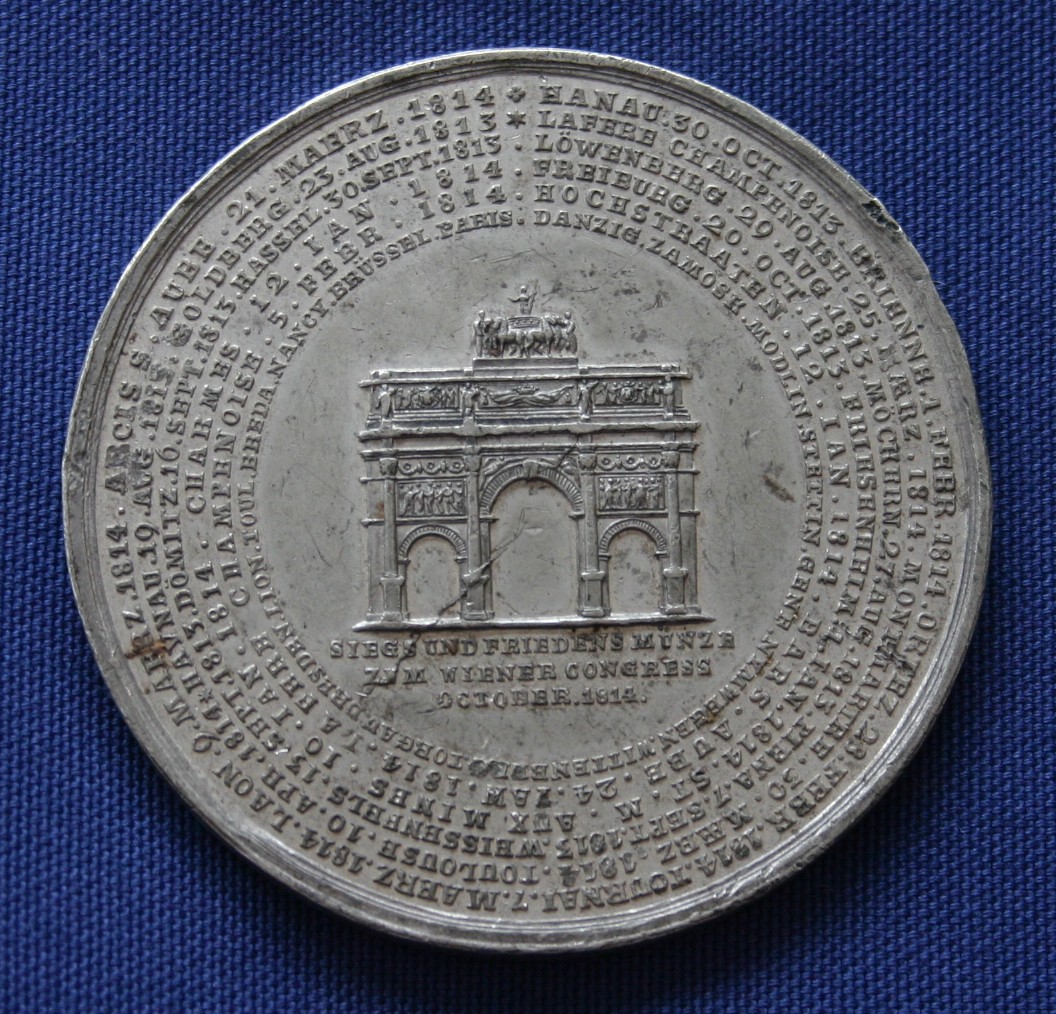|
Irish Legion
The Irish Legion () was a light infantry regiment in service of the French Imperial Army established in 1803 for an anticipated invasion of Ireland. It was later expanded to a four battalions and a depot, the legion won distinction in the Walcheren Expedition, the Peninsular War, and the German campaign of 1813. Following the disbandment of the foreign regiments in 1815, the regiment's personnel were distributed. Establishment The first officers included members of the Society of United Irishmen who had fled to France in 1797. It also included Irishmen who had been taken during the 1798 rebellion who were freed during the short peace effected by the Treaty of Amiens on condition of exile, and who had sailed for France in June 1802. The treaty broke down in May 1803 with the start of the War of the Third Coalition. As a part of Napoleon's planned invasion of the United Kingdom in 1803–05, the Irish Legion was to provide the indigenous core for a much larger invasion force of ... [...More Info...] [...Related Items...] OR: [Wikipedia] [Google] [Baidu] |
Light Infantry
Light infantry refers to certain types of lightly equipped infantry throughout history. They have a more mobile or fluid function than other types of infantry, such as heavy infantry or line infantry. Historically, light infantry often fought as Reconnaissance, scouts, Raid (military), raiders, and skirmishers. These are loose formations that fight ahead of the main army to harass, delay, disrupt supply lines, engage the enemy's own skirmishing forces, and generally "soften up" an enemy before the main battle. Light infantrymen were also often responsible for Screening (tactical), screening the main body of a military formation. Following World War II, the term "light infantry" has evolved to include rapid-deployment units (including commando and Airborne forces, airborne units) that emphasize speed and mobility over armor and firepower. Some units or battalions that historically held a skirmishing role retain their designation "light infantry" for the sake of tradition. His ... [...More Info...] [...Related Items...] OR: [Wikipedia] [Google] [Baidu] |
Battle Of Hanau
The Battle of Hanau was fought from 30 to 31 October 1813 between Karl Philipp von Wrede's Austro-Bavarian corps and Napoleon's retreating French during the War of the Sixth Coalition. Following Napoleon's defeat at the Battle of Leipzig earlier in October, Napoleon began to retreat from Germany into France and relative safety. Wrede attempted to block Napoleon’s line of retreat at Hanau on 30 October. Napoleon arrived at Hanau with reinforcements and defeated Wrede’s forces. On 31 October Hanau was in French control, opening Napoleon’s line of retreat. The Battle of Hanau was an important tactical victory allowing Napoleon’s depleted army to retreat onto French soil to prepare to face an invasion of France. Background The Battle of Leipzig, the largest and bloodiest encounter of the Napoleonic Wars, began on 16 October 1813, raged for three days and ended with a decisive victory for the Sixth Coalition. Napoleon was forced to abandon central Germany to the coa ... [...More Info...] [...Related Items...] OR: [Wikipedia] [Google] [Baidu] |
Pierre Augereau
Charles Pierre François Augereau, duc de Castiglione (; 21 October 1757 – 12 June 1816) was a French military commander and a Marshal of the Empire who served during the French Revolutionary Wars and the Napoleonic Wars. After serving in the Revolutionary Wars, he earned rapid promotion while fighting against Spain and soon found himself as a division commander under Napoleon Bonaparte in Italy. He fought in all of Bonaparte's battles of 1796 with great distinction. During the Napoleonic Wars, Napoleon entrusted Augereau with important commands. His life ended under a cloud because of his poor timing in switching sides between Napoleon and Louis XVIII. Napoleon wrote of Augereau that he "has plenty of character, courage, firmness, activity; is inured to war; is well liked by the soldiery; is fortunate in his operations". Augereau is generally counted as one of the most capable generals of the Napoleonic Wars. Early years Augereau was born in Faubourg Saint-Marceau, Paris, as ... [...More Info...] [...Related Items...] OR: [Wikipedia] [Google] [Baidu] |
Morlaix
Morlaix (; , ) is a commune in the Finistère department of Brittany in northwestern France. It is a sub-prefecture of the department. History The Battle of Morlaix, part of the Hundred Years' War, was fought near the town on 30 September 1342 between the English under William de Bohun, Earl of Northampton and the French under Charles, Duke of Brittany. The result was an English victory and has been viewed by historians as presaging the battle tactics of the Battle of Crécy four years later. Leisure and tourism The old quarter of the town has winding streets of cobbled stones and overhanging houses constructed of stone and timber. Many have religious and secular sculptures on their façades. One of these houses is "la Maison dite de la duchesse Anne", or the "so-called Duchess Anne’s house", which is now a museum, open to the public. This house is said to be one of the oldest in the town. Local legend has it that it derives its name from the fact that the Duchesse ... [...More Info...] [...Related Items...] OR: [Wikipedia] [Google] [Baidu] |
Napoleon's Planned Invasion Of The United Kingdom
Napoleon's planned invasion of the United Kingdom at the start of the War of the Third Coalition, although never carried out, was a major influence on British naval strategy and the fortification of the coast of South East England. In 1796 the French had already tried to French expedition to Ireland (1796), invade Ireland in order to destabilise the United Kingdom or as a stepping-stone to Great Britain. The first French Army of England had gathered on the English Channel, Channel coast in 1798, but an invasion of England was sidelined by Napoleon's concentration on the campaigns in French campaign in Egypt and Syria, Egypt and against Italian campaigns of the French Revolutionary Wars#Bonaparte's war, Austria, and shelved in 1802 by the Treaty of Amiens, Peace of Amiens. Building on planning for mooted invasions under France's ''ancien régime'' in Planned French invasion of Britain (1744), 1744, Planned French invasion of Britain (1759), 1759, and Armada of 1779, 1779, preparation ... [...More Info...] [...Related Items...] OR: [Wikipedia] [Google] [Baidu] |
War Of The Third Coalition
The War of the Third Coalition () was a European conflict lasting from 1805 to 1806 and was the first conflict of the Napoleonic Wars. During the war, First French Empire, France and French client republic, its client states under Napoleon I and its ally Spain opposed an alliance, the Third Coalition, which was made up of the United Kingdom of Great Britain and Ireland, United Kingdom, the Austrian Empire, the Russian Empire, Kingdom of Naples, Naples, Kingdom of Sicily, Sicily, and Sweden. Kingdom of Prussia, Prussia remained neutral during the war. Britain had already been at war with France following the breakdown of the Treaty of Amiens, Peace of Amiens and remained the only country still at war with France after the Treaty of Pressburg (1805), Treaty of Pressburg. From 1803 to 1805, Britain stood under constant threat of a Napoleon's planned invasion of the United Kingdom, French invasion. The Royal Navy, however, assured its naval dominance at the Battle of Trafalgar in Oc ... [...More Info...] [...Related Items...] OR: [Wikipedia] [Google] [Baidu] |
Treaty Of Amiens
The Treaty of Amiens (, ) temporarily ended hostilities between France, the Spanish Empire, and the United Kingdom at the end of the War of the Second Coalition. It marked the end of the French Revolutionary Wars; after a short peace it set the stage for the Napoleonic Wars. Britain gave up most of its recent conquests; France was to evacuate Naples and Egypt. Britain retained Ceylon (Sri Lanka) and Trinidad. It was signed in the Hôtel de Ville (City Hall) of Amiens on 25 March 1802 (4 Germinal X in the French Revolutionary calendar) by Joseph Bonaparte and Charles Cornwallis, 1st Marquess Cornwallis as a "Definitive Treaty of Peace". The consequent peace lasted only one year (18 May 1803) and was the only period of general peace in Europe between 1793 and 1814. Under the treaty, Britain recognised the French Republic. Together with the Treaty of Lunéville (1801), the Treaty of Amiens marked the end of the Second Coalition, which had waged war against Revolutionary F ... [...More Info...] [...Related Items...] OR: [Wikipedia] [Google] [Baidu] |
1798 Rebellion
The Irish Rebellion of 1798 (; Ulster-Scots: ''The Turn out'', ''The Hurries'', 1798 Rebellion) was a popular insurrection against the British Crown in what was then the separate, but subordinate, Kingdom of Ireland. The main organising force was the Society of United Irishmen. First formed in Belfast by Presbyterians opposed to the landed Anglican establishment, the Society, despairing of reform, sought to secure a republic through a revolutionary union with the country's Catholic majority. The grievances of a rack-rented tenantry drove recruitment. While assistance was being sought from the French Republic and from democratic militants in Britain, martial-law seizures and arrests forced the conspirators into the open. Beginning in late May 1798, there were a series of uncoordinated risings: in the counties of Carlow and Wexford in the southeast where the rebels met with some success; in the north around Belfast in counties Antrim and Down; and closer to the capital, Du ... [...More Info...] [...Related Items...] OR: [Wikipedia] [Google] [Baidu] |
Society Of United Irishmen
The Society of United Irishmen was a sworn association, formed in the wake of the French Revolution, to secure Representative democracy, representative government in Ireland. Despairing of constitutional reform, and in defiance both of British Crown forces and of Irish Sectarianism, sectarian division, in 1798 the United Irishmen instigated Irish Rebellion of 1798, a republican rebellion. Their suppression was a prelude to the abolition of the Parliament of Ireland, Irish Parliament in Dublin and to Ireland's incorporation in a United Kingdom of Great Britain and Ireland, United Kingdom with Kingdom of Great Britain, Great Britain. Espousing principles they believed had been vindicated by American Revolution, American independence and by the Declaration of the Rights of Man and of the Citizen, French Declaration of the Rights of Man, the Presbyterian Church in Ireland, Presbyterian merchants who formed the first United society in Belfast in 1791 vowed to make common cause with ... [...More Info...] [...Related Items...] OR: [Wikipedia] [Google] [Baidu] |
German Campaign Of 1813
The German campaign () was fought in 1813. Members of the Sixth Coalition, including the German states of Austria and Prussia, plus Russia and Sweden, fought a series of battles in Germany against the French Emperor Napoleon, his marshals, and the armies of the Confederation of the Rhine – an alliance of most of the other German states –, which ended the domination of the First French Empire. After the devastating defeat of Napoleon's ''Grande Armée'' in the Russian campaign of 1812, Ludwig Yorck von Wartenburg, Johann Yorck – the general in command of the ''Grande Armée'''s German auxiliaries (') – declared a ceasefire with the Russians on 30 December 1812 via the Convention of Tauroggen. This was the decisive factor in the outbreak of the German campaign the following year. The spring campaign between France and the Sixth Coalition ended inconclusively with a summer truce (Truce of Pläswitz). Via the Trachenberg Plan, developed during a period of ceasefire in the sum ... [...More Info...] [...Related Items...] OR: [Wikipedia] [Google] [Baidu] |
Walcheren Expedition
The Walcheren Campaign () was an unsuccessful British expedition to the Kingdom of Holland in 1809 intended to open another front in the Austrian Empire's struggle with France during the War of the Fifth Coalition. John Pitt, 2nd Earl of Chatham, the commander of the expedition, was ordered to capture the towns of Flushing and Antwerp and thus enable British ships to safely traverse the Scheldt River. A British expeditionary force of 39,000 troops, together with field artillery and two siege trains, crossed the North Sea and landed at Walcheren on 30July. This was the largest British expedition of that year, larger than the army serving in the Peninsular War in the Iberian Peninsula. Nevertheless, it failed to achieve any of its goals. The campaign involved little fighting, but heavy losses from the sickness popularly dubbed "Walcheren Fever". Although more than 4,000 British troops died during the expedition, only 106 were killed in action; the survivors withdrew on 9Dec ... [...More Info...] [...Related Items...] OR: [Wikipedia] [Google] [Baidu] |
Irish Rebellion Of 1803
The Irish rebellion of 1803 was an attempt by Irish Republicanism, Irish republicans to seize the seat of the British government in Ireland, Dublin Castle, and trigger a nationwide insurrection. Renewing the Irish Rebellion of 1798, struggle of 1798, they were organised under a reconstituted Society of United Irishmen, United Irish directorate. Hopes of French aid, of a diversionary rising by radical militants in England, and of Presbyterian Church in Ireland, Presbyterians in the north-east rallying once more to the cause of a republic were disappointed. The rising in Dublin misfired, and after a series of street skirmishes, the rebels dispersed. Their principal leader, Robert Emmet, was executed; others went into exile. Strategy of the new United Irish directory In the aftermath of the 1798 rebellion a number of younger United Irishmen were still at liberty, but in communication with state prisoners held at Fort George, Highland, Fort George in Scotland, worked to re-estab ... [...More Info...] [...Related Items...] OR: [Wikipedia] [Google] [Baidu] |







